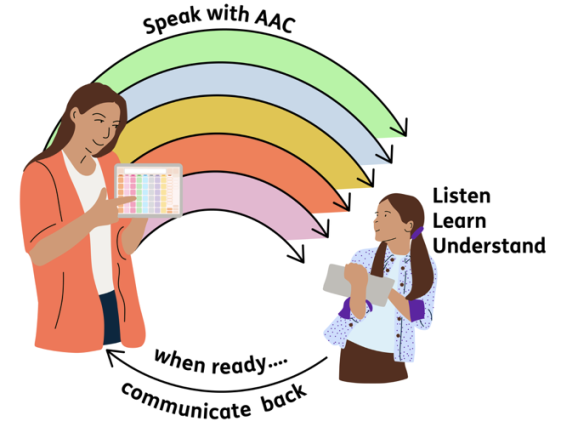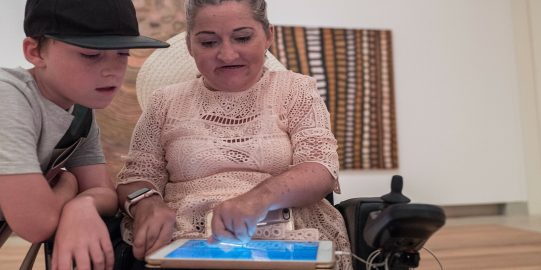What is Aided Language Stimulation?
Aided Language Stimulation (ALS) is sometimes referred to as modeling, Aided Language Modeling, Aided Language Input, or Natural Aided Language. It is an evidence-based technique that supports AAC users to develop language and communication.
During Aided Language Stimulation, a communication partner speaks while pointing to symbols or words on the AAC device. This allows the AAC user to see their device used in authentic situations.
Aided Language Stimulation is a strategy taught to communication partners. It involves modeling or showing language on an AAC device by pointing to the symbols or words. Communication partners provide input in the same “language” we teach the AAC user to output.
It is so important for AAC users to see their device in action. We wouldn’t expect a child to learn to talk without hearing the language around them. So, it’s unrealistic to expect someone using AAC to figure it out without seeing it used in real communication situations. We know this is how children learn language and how immersion supports learning foreign languages—it’s the same for AAC users learning to navigate their device.
Think about when a baby is learning to speak. They watch and listen to people around them speaking. They listen to words and sounds for a long time before they try to speak themselves. Then, they start to explore their voice through babbling before speaking their first words. This is “Language Stimulation” and is accepted as how babies learn language from their caregivers.
Similarly, AAC users need this time to listen and watch the people around them communicating on their device. They show language on their AAC - “and aide” or tool. This is Aided Language Stimulation.
Why should we use Aided Language Input?
Research strongly supports using Aided Language Stimulation. Many studies show that using ALS leads to better results in AAC. Let’s dive into some key points.
Language Development: During Aided Language Stimulation, the AAC user is constantly exposed to language examples using their AAC device. This can lead to improvements in both understanding and also expressing language.
Symbolic Communication: Aided Language Stimulation on a symbol-based AAC device or app like Proloquo2Go, Proloquo, or simPODD shows the AAC user the link between the symbols on the AAC device and the spoken word. This connection helps to develop symbolic communication skills, making it easier for AAC users to express themselves using AAC.
Social Interaction: Including Aided Language Stimulation in social interactions can encourage participation and engagement for AAC users across various settings.
Generalization of skills: When we consistently use Aided Language Stimulation in different situations, it helps the AAC user see how to use their AAC more widely. This can lead to improved communication in different environments, situations, and with different people.
What is the difference between Aided Language and modeling?
Let’s explore the difference between Aided Language Stimulation and Modeling—terms often used interchangeably, with ‘Aided Language Stimulation’ being the more formal choice and ‘modeling’ being a bit less formal.
While the terms are mostly interchangeable, there are subtle differences. Aided Language Stimulation specifically involves speaking while pointing to words on the device. On the other hand, when using the term’ modeling,’ speaking may or may not occur, depending on the AAC user’s preference.
In certain research studies, ‘modeling’ may refer to a behavioral/response approach where an adult models, the child copies, and the child receives a reinforcer. This is different from the concept we’re talking about here.
Whether you refer to it as ‘modeling’ or ‘Aided Language Stimulation’ or use them interchangeably, the key is that, as a communication partner, you’re using the AAC device for communication, just as the AAC user is learning to do. Speak AAC to teach AAC. There’s no need for the AAC user to copy; the focus is on natural communication and interaction. Feel free to use the term that feels most comfortable for you and the AAC user!





